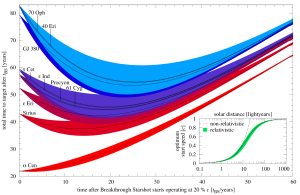Blog
The Waiting Game
3 June 2021
 René Heller
René HellerSo, you’ve decided to travel to another star system. Say, the Trappist System, which has a handful of potentially habitable worlds. You’re very keen, and you’d like to get there as soon as possible. But the system is 40 light-years away, and that raises an interesting question. To get there ASAP, when do you head out?
The obvious answer is to leave as soon as your ship is ready. That’s perfectly reasonable if you are traveling around our planet, but the scale of interstellar distances makes the answer a bit more complex.
Given our current technology, we can easily build an ion drive space probe with a maximum speed of around 50,000 km/hr. That’s incredibly fast, but it would take such a probe more than 800,000 years to reach the Trappist system. But suppose we learn to make nuclear-powered rockets? By some estimates, a nuclear ship could reach Mars in only 90 days and would cut our Trappist voyage down to 10,000 years or so. If you think we’ll have nuclear rockets in the next 700,000 years, then you should wait.
Because interstellar travel takes so long, technology could significantly improve during your journey. You could build a massive generation ship to Trappist-1, only for your descendants to find a thriving colony when the ship arrived, because a century after your voyage started humans invent warp drive. This idea is a common trope of science fiction, but it has also been studied as a real challenge.1
It’s known as the wait calculation, and it’s an attempt to calculate your best options. If a technological breakthrough is likely, you hold off to let the technology mature. If technology seems stagnant, then pack your bags. No matter which option you choose, you can never be sure. But if you always choose to wait, then you will never reach the stars. Things get more complicated when you take relativity into account.2 When your ship reaches a good fraction of light speed, your travel time becomes relativistically shorter. Even if your ship doesn’t arrive first, it still might be worth it because of relativistic time.
But one thing is clear. Those of us alive today don’t have to make that choice. Our technology is currently so feeble that we can’t build an interstellar ship. We might be able to a probe in the next century, such as the proposed Breakthrough Starshot mission, but humans won’t be making a trip any time soon. So all we can do is wait, and hope our children are very clever.
Kennedy, Andrew. “Interstellar travel: The wait calculation and the incentive trap of progress.” Journal of the British Interplanetary Society 59.7 (2006): 239-246. ↩︎
Heller, René. “Relativistic generalization of the incentive trap of interstellar travel with application to Breakthrough Starshot.” Monthly Notices of the Royal Astronomical Society 470.3 (2017): 3664-3671. ↩︎